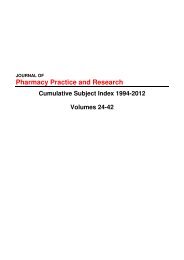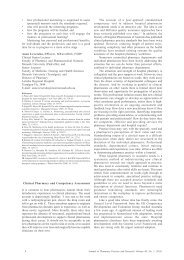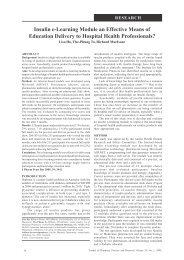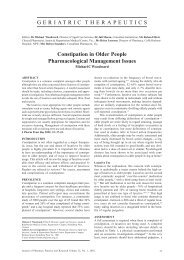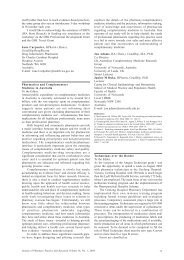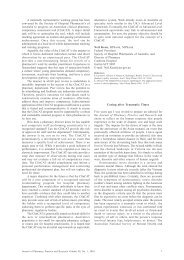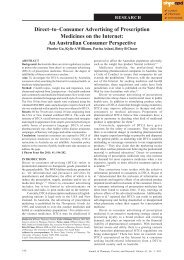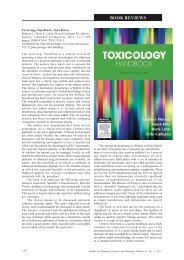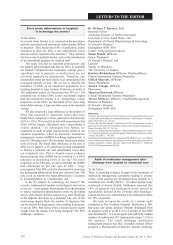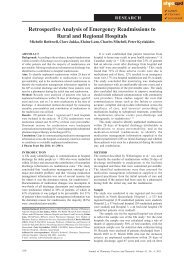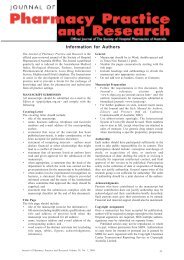Fred J Boyd 2007 Award - jppr
Fred J Boyd 2007 Award - jppr
Fred J Boyd 2007 Award - jppr
You also want an ePaper? Increase the reach of your titles
YUMPU automatically turns print PDFs into web optimized ePapers that Google loves.
the guidelines for safe handling of cytotoxic drugs in pharmacy<br />
departments and hospital wards; they were updated in 1982<br />
to include the recommendation of using a laminar flow cytotoxic<br />
drug safety cabinet.<br />
Unfortunately, the 80s were also the era of economic<br />
rationalism, recurrent cost-containment measures, Booz-Allen<br />
reviews, and perceived fat trimming. We struggled to justify<br />
the costs of clinical pharmacists. In 1985, the year I was<br />
appointed as Chief Pharmacist, there were no fewer than eight<br />
articles published in the AJHP on clinical pharmacist workloads<br />
and activities, and the first costing study was published to<br />
demonstrate cost justification of clinical services. These surveys<br />
and activities, published and promoted by SHPA, assisted<br />
pharmacy managers to promote clinical pharmacy as part of a<br />
comprehensive pharmacy service.<br />
Chris Doecke, at the 1991 Federal Conference, heralded<br />
the path of clinical pharmacy in the 1990s by asking the<br />
question, ‘Why are we still talking about putting theory into<br />
practice after 20 years. We must move to measuring<br />
improvement in patient outcomes, ensuring the quality of our<br />
services, focus on appropriate drug use and collaborate in<br />
changing prescribing practices’.<br />
Quality Assurance, Total Quality Management, and Quality<br />
Use of Medicines thus became the themes of the late 80s and<br />
90s, focusing on not what we did, but what we achieved. Many<br />
initiatives were published and taken up to promote Quality Use<br />
of Medicines. In 1992, the Quality Assurance COSP published<br />
the first SHPA performance indicators and in 1996 Standards<br />
of Practice for Drug Usage Review were published. In 1993,<br />
pharmacoeconomics was the theme of the Sydney Federal<br />
Conference. There were many attempts, facilitated by SHPA,<br />
to train us in drug use economics, quality of life year assessments,<br />
decision analysis, pharmacoeconomic evaluations, and we tried<br />
to apply these principles to our drug and therapeutic committee<br />
decisions—in my case, a miserable failure.<br />
In the 90s we were called upon to provide evidence of<br />
the value of clinical pharmacy services. SHPA was unwavering<br />
in its support for pharmacy managers and in 1998 commissioned<br />
the clinical pharmacy intervention study demonstrating that<br />
routine review of patient drug therapy saves lives, improves<br />
patient care, reduces length of stay and saves money. Although,<br />
by the start of the new millennium, the quality and safety agenda<br />
had been taken up and clinical pharmacists were indelibly<br />
viewed as critical to safe medication practices, the study, finally<br />
published in 2003, confirmed the Safety and Quality Council’s<br />
view that the provision of clinical pharmacy services reduces<br />
medication incidents.<br />
This leads me to mention the overall health policy changes<br />
that have impacted over the past three decades on our ability<br />
to get on with saving lives. Although, I thought we did pretty<br />
well in the 70s (after all, it was before ACT self government<br />
and Royal Canberra Hospital was Commonwealth funded with<br />
what seemed like unlimited resources), the 1980s were times<br />
of constant change; curtailed staff levels, workload growth,<br />
oppressive financial restrictions, hospital closures (including my<br />
own, Royal Canberra Hospital) and amalgamations which led<br />
to major upheavals of pharmacy departments. In the 1990s,<br />
changing organisational structures in hospitals affected most<br />
pharmacies. Organisation restructuring was a feature of the<br />
1995 Federal Conference in Melbourne. There was much<br />
debate in the AJHP about whether we should join an allied<br />
health division. There were issues of power and politics, seeking<br />
of greater recognition and greater resource allocation. There<br />
was the emergence of alternatives to the functionally based<br />
divisional structures to product-focused or matrix structures,<br />
with decentralised management and devolvement of costs.<br />
We also had DRGs, clinical costings, cost weights and<br />
casemix funding to contend with in the 90s, SHPA again being<br />
heavily involved in supporting pharmacy managers with these<br />
new considerations. And thence to the jargon of the new century:<br />
clinical streaming, patient-centred care, service integration,<br />
organisational capability, clinical and corporate governance,<br />
stakeholders, benchmarking, accountability, clinical risk<br />
management, frameworks, clinical and non-clinical outputs,<br />
flexible models. I would like to quote from ACT Health’s current<br />
Quality and Safety Strategic Plan: ‘The clinical governance<br />
framework has been established to provide explicit lines of<br />
accountability with a clearly defined management structure that<br />
allows facilitation, coordination, monitoring, evaluation and<br />
feedback of the services provided, and is based on a set of<br />
guiding dimensions to quality and safety that are built around<br />
four key interlocked strategic areas; clinical competence, clinical<br />
effectiveness, clinical risk management and system enhancement<br />
and accountability’. Well, good luck Neil!<br />
My message in mentioning just a few of the changes that<br />
our profession has seen over the period of my career is in the<br />
following questions: How did I manage these changes? How<br />
was I able to adapt to change? How did I find the information<br />
and gain the knowledge and competence to facilitate such<br />
changes? How did I become informed and educated in order<br />
to progress and introduce new services?<br />
The answer is SHPA. SHPA provides us conferences,<br />
seminars, lectures, the Journal, the bulletin, COSPs, guidelines,<br />
position statements, grants and awards, and advocacy to name<br />
but a few things. It provides us with the opportunities to build<br />
awareness and an understanding of the current environment,<br />
for networking, for sharing experiences, disseminating<br />
information, making lifelong friends and contacts, for learning<br />
and providing the know-how to institute change, progress and<br />
improve. Or to quote from the current CPD program it keeps<br />
us current, informed and connected.<br />
My career was and still is, inextricably tied to being a<br />
member of and being involved with SHPA. I am proud to have<br />
served on Federal Council, the State Branch Committee and<br />
various COSPs and to be involved with educating and informing<br />
others. However, I can’t begin to say how valuable that<br />
involvement has been to my own career. Being so well informed<br />
through this involvement has meant that I have been able to<br />
facilitate change, develop, and improve the services in the<br />
hospitals that I have worked.<br />
SHPA provides the way that our profession communicates<br />
and informs; so I urge you to get involved, give back to SHPA<br />
some of what it has given you. I know this will be a hard<br />
concept to grasp for the members of the Y generation in the<br />
audience, but I urge you to think about, not what SHPA can<br />
do for you, but what you can do for it.<br />
In closing I would like to use the words of the late Pam<br />
Nieman when she accepted this award in 1995 (and she would<br />
be very upset about missing this Conference). ‘We owe a debt<br />
to our profession. It serves us well through our lifetime —so<br />
we must give back to it’.<br />
Thank you SHPA, which is all of you, for what you have<br />
done for me.<br />
Sue Alexander delivered her oration on 10 November <strong>2007</strong><br />
at the 28th SHPA Federal Conference in Sydney.<br />
Journal of Pharmacy Practice and Research Volume 37, No. 4, <strong>2007</strong> 317



